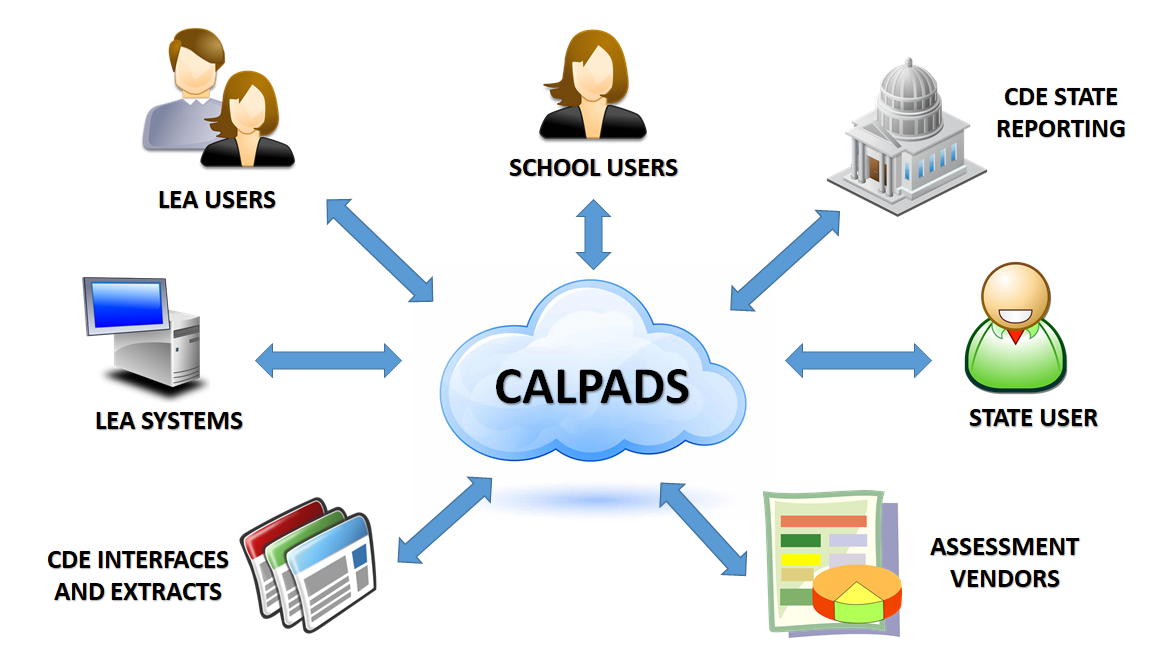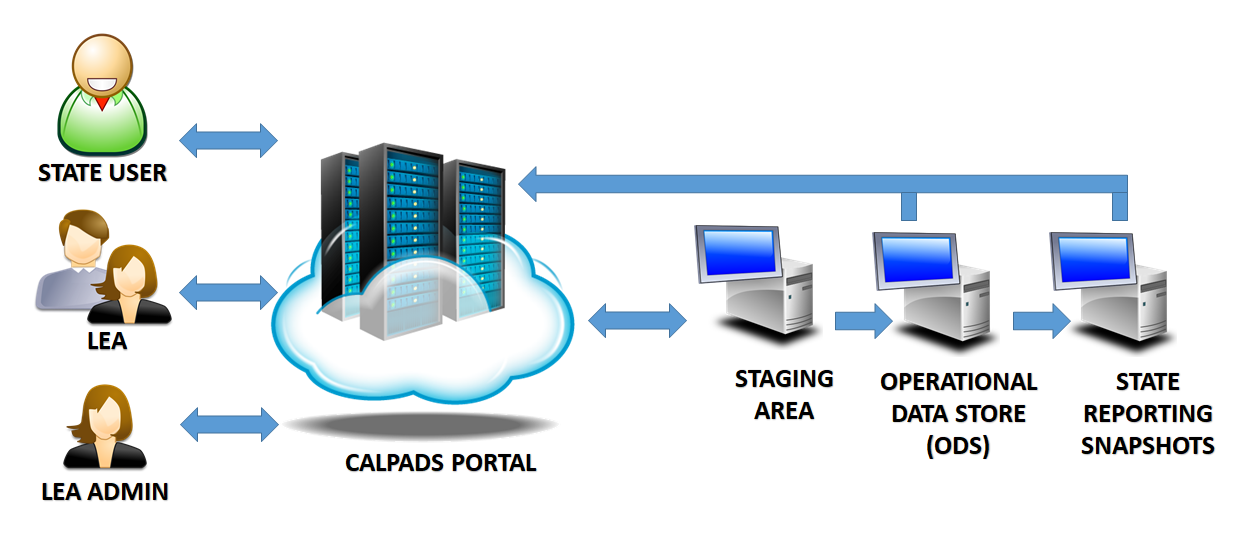Overview
CALPADS is the foundation of California’s K–12 education data system, comprising student demographic, program participation, grade level, enrollment, course enrollment and completion, discipline, and statewide assessment data. The student-level, longitudinal data in CALPADS enables the facilitation of program evaluation, the assessment of student achievement over time, the calculation of more accurate dropout and graduation rates, the efficient creation of reports to meet state and federal reporting requirements, and the ability to create ad hoc reports and responses to relevant questions. CALPADS provides local educational agencies (LEAs) with access to longitudinal data and reports on their own students, and it gives LEAs immediate access to information on new students, enabling the LEAs to place students appropriately and to determine whether any assessments are necessary.
In order to meet the requirements of California Education Code Section 60900, LEAs shall retain and report to CALPADS individual pupil and staff records, including:
- Statewide Student Identifier (SSID) data
- Student enrollment and exit data
- All necessary data to produce required graduation and dropout rates
- Demographic data
- Other data elements deemed necessary by the State Superintendent of Public Instruction, with approval of the State Board of Education, to comply with the federal reporting requirements.
LEA maintenance of individual SSIDs includes the accurate and timely reporting of demographic, program, local student enrollment and exit data to CALPADS, and the timely resolution of SSID anomalies with other LEAs.
What does CALPADS do for local educational agencies?
CALPADS provides LEAs with:
- Access to longitudinal data and reports on their own students.
- Immediate access to information on new students, such as the students’ program participation, English learner (EL) statuses, and assessment scores.
- An efficient means for meeting state and federal reporting requirements.
- Student counts that can be used to project funding levels.
- Identification of students who are automatically eligible for free meals under the National School Lunch Program (NSLP), or who are foster youths.
How does this benefit LEAs?
Access to this information enables LEAs to:
- Place students appropriately.
- Determine whether any assessments are necessary.
- Locate students thought to have dropped out.
- Analyze data to support local decision making.
- Provide free meals to eligible students.
- Provide services and support to foster youth.
Types of data in CALPADS
The following table illustrates the types of data captured in CALPADS. Each of these types of data is represented by data elements that have specific names and definitions. All of the data elements used in CALPADS, along with their definitions, can be found in the CALPADS File Specifications.
| Student data include: | Staff data include: | Course data include: |
|---|---|---|
| Enrollment | Demographic | Detailed information on course offerings (e.g. English learner services, class size) |
| Demographics | Job classification by full-time equivalency (FTE) | Teachers assigned to courses |
| Program eligibility and participation | Assignment | |
| Program information and services | Service years | |
| Career Technical Education | ||
| Grade level | ||
| English language acquisition status | ||
| Course enrollment and completion | ||
| Discipline (suspensions and expulsions) | ||
| Student Absenteeism Summary | ||
| Statewide assessment | ||
| Foster status | ||
Features
The following are key features of CALPADS that will differentiate it from the prior data collection and reporting mechanisms:
- Web-based system, requiring no client software
- One point of entry for all CALPADS functions, including SSID request and maintenance
- Submission of individual student/staff level data replacing aggregate reporting where appropriate (e.g., California Basic Educational Data System [CBEDS], Language Census [LCEN], Student National Origin Report [SNOR])
- Data submission via various submission methods:
- Online
- Batch
- Data updated on an ongoing basis
- Submission process managed with:
- Workflows for submitting and approving data
- Online views of exception reports
- Views of data submitted prior to posting to the system
- Confirmations of data initiating the posting to the system
- A complete profile of a student’s enrollment history, course completion, program participation and assessment scores (e.g., previous assessment scores and California English Language Development Test [CELDT] administration), providing information immediately on new and existing students
- Student demographic information used in assessment and Academic Performance Index (API) and Adequate Yearly Progress (AYP) reporting updated in CALPADS instead of through the assessment vendor (eliminating additional cost to the LEA)
- Data for an individual student submitted online
- Reporting capabilities including:
- A view of data stored in CALPADS prior to certification
- The ability to print reports as well as download reports in Comma-Separated Values (CSV), Excel, etc. formats
- The ability to filter report data based on user-selected filters (e.g., district, school site, grade level, demographics, program participation, etc.)
Intended Users
The CALPADS solution is designed to accommodate the diverse needs of various users and interfacing systems. CALPADS will accommodate several types of interactions: user interactions, system interactions, and interface interactions. The image below depicts these interaction points at a high level.

Each of these interactions will have different needs; therefore, the system will provide different capabilities depending on the type of interaction.
User Interaction
LEA User
- Manage Statewide Student Identifiers (SSID), enrollment, state reporting, and assessment data
- Validate data submitted
- Certify data for state reporting
- Administer users (within LEA)
School User
- Manage SSID, enrollment, state reporting, and assessment data
- Validate data submitted
State User
- Manage state reporting, workflow, and data collection windows
- Manage the list of expected schools
- Administer users (state accounts and CALPADS LEA Administration accounts)
- Administer data (submissions, workflows, metadata, reference data, etc.)
- Manage external data requests in compliance with state and federal privacy laws (Family Educational Rights Privacy Act [FERPA], etc.)
The CDE Interfaces and Extracts
Provide and receive data to and from the following external systems and processes
- Adequate Yearly Process (AYP) calculation process
- County District School Code / Educational Service Institution system
- National School Lunch Program (NSLP) Direct Certification
- Foster Youth Matches
System Components
The components of CALPADS supporting the interactions above are depicted in the graphic below.

Each of these components is described below.
Portal
The Portal will provide users the ability to:
LEA Users
- Submit and review required data transmissions via batch or online
- Maintain LEA specific information regarding data submission and auditing
- Perform reporting and data extraction activities
CALPADS LEA Administrators
- Control local access to CALPADS
- Create new accounts and sets specific roles for LEA users
- Administer all local CALPADS users
Staging Area
The Staging Area is the temporary storage for LEA submitted data until these are corrected, validated, and approved for loading to the CALPADS Operational Data Store (ODS). The Staging Area is the initial data loading point for all data submissions.
Operational Data Store (ODS)
The ODS captures and maintains all validated student and teacher related data submitted from the LEAs. This data store is the source of snapshot reporting and data extraction.
State Reporting Snapshots
The state reporting snapshot is a view of data in the CALPADS ODS at particular points-in-time based on a data collection window. Before the start of the data collection window, CALPADS takes a current snapshot of data form the ODS and stores it in the Snapshot database. The LEA has an opportunity to review and certify each snapshot. Once certified the data is frozen for official state reporting and analysis.
Hardware and Software Requirements
CALPADS is a web-based software application. There are no special hardware considerations needed. For optimum performance, the Web pages and Web-based applications hosted by the California Department of Education (CDE) require a current Web browser. It is the intent of CDE that all of its Web pages and Web-based applications will work well with the latest stable releases of Microsoft Edge, Google Chrome, Mozilla Firefox, Apple Safari, and Microsoft Internet Explorer 11.
Web browsers that are fully compatible with these browsers may also be suitable, but CDE does not design, maintain, or test for browsers that are not listed above. If you are not sure of the version of your browser, select Help in the menu bar of your browser and choose About.